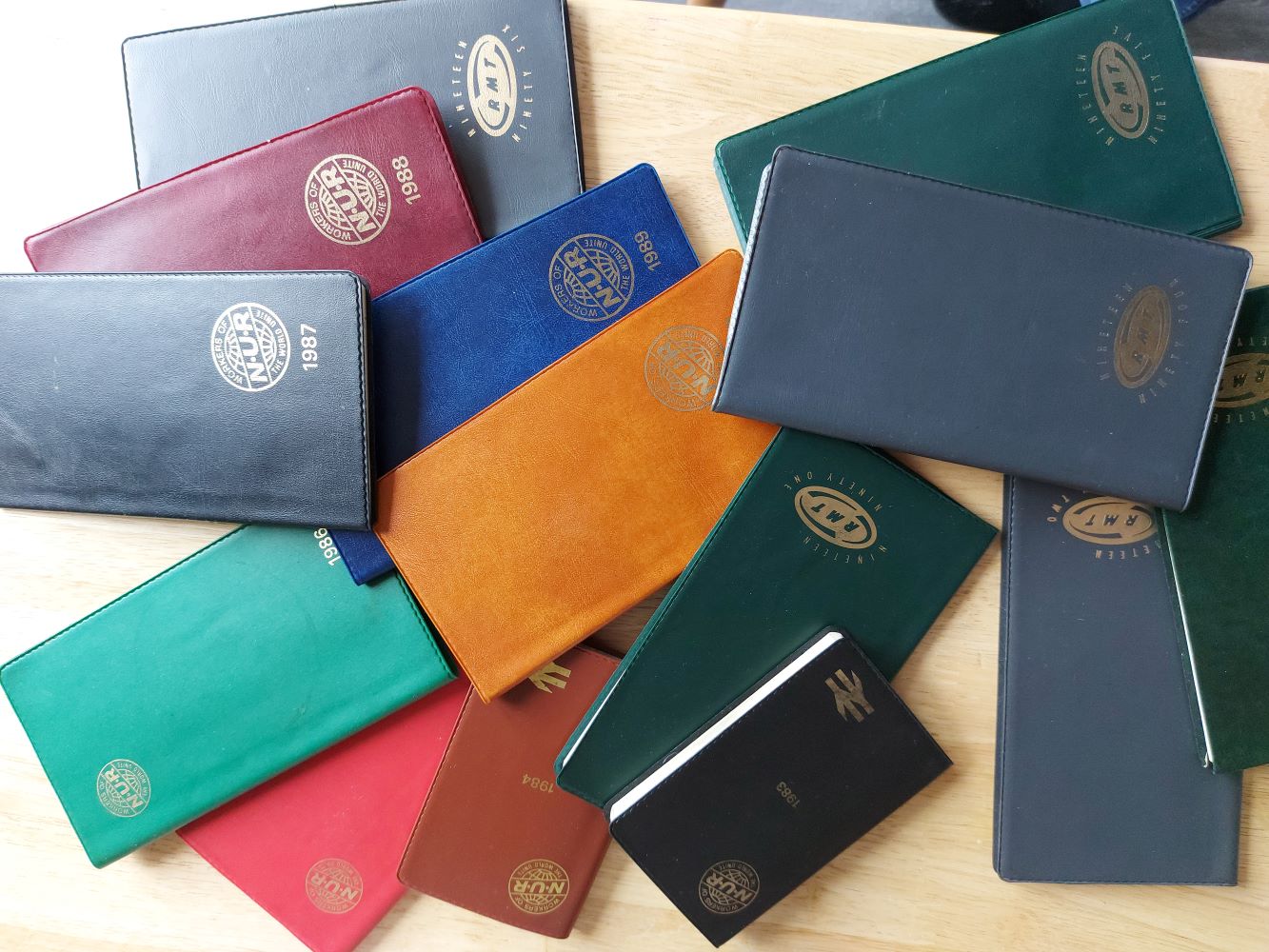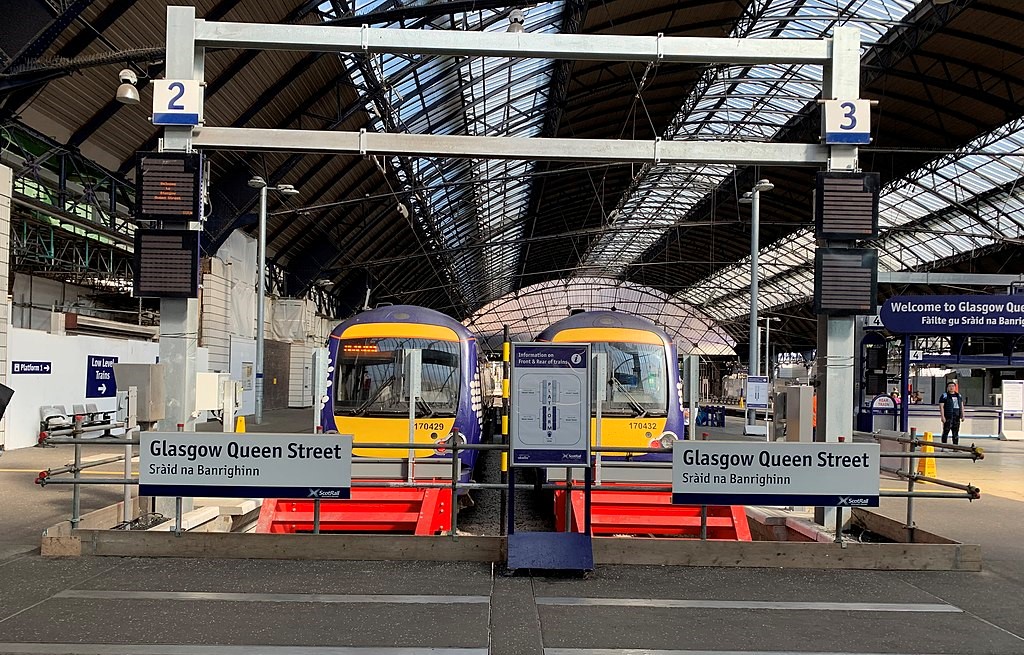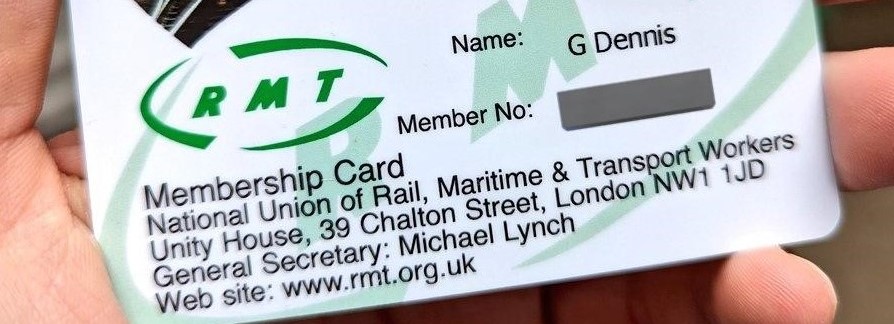Find out more about The Open University's Social Sciences courses.
Background
The provision of diaries has long been part of the service that many unions provide for their members. Even in this era of online calendars and diaries, a hard copy union diary was often gratefully received by trade unionists, a good place to note details of shifts, holidays and other work-related information – in addition to many other aspects of daily life. Often these would arrive alongside a union magazine, for example the RMT News, and for some members the diary was regarded as in some ways like the official membership card, as another sign of belonging and identifying with a particular union. Here Ann Henderson reflects on what a membership card meant to her during her time in the railway industry in Scotland.
The enduring significance of a trade union membership card
 Ann's collection of Union diaries.During my time in the railway, the National Union of Railwaymen (NUR) and Rail, Maritime and Transport (RMT) diaries were designed with a small pocket at the back, to hold the cardboard membership card (apart from the year of 1993, when the design changed. Protests must have led to the reinstatement of the plastic card holder, as it was there again in 1994).
Ann's collection of Union diaries.During my time in the railway, the National Union of Railwaymen (NUR) and Rail, Maritime and Transport (RMT) diaries were designed with a small pocket at the back, to hold the cardboard membership card (apart from the year of 1993, when the design changed. Protests must have led to the reinstatement of the plastic card holder, as it was there again in 1994).
The diaries and cards carried the NUR logo until 1990, then moved onto the new RMT logo.
From my membership cards I can put together more memories of my time working in the railway, and also identify other information about the trade union’s work at that time.
The membership cards carry my National Insurance (NI) number, union membership number, my home address, and the details of my NUR/RMT Branch secretary, along with contact details and the time and place of the regular branch meetings. The membership year ran from 1 October to 30 September the following year.
I joined the railway (British Rail) late 1982. My first NUR card shows me as a member of Glasgow no. 6 Branch. I worked as a Leading Railman at Hyndland Station, Glasgow. The union branch meetings were held in the Trades Council building by the River Clyde, Carlton Place, on Tuesday evenings. I was usually the only woman at the meetings. I took on the role of Minutes Secretary either in 1983 or 1984.
In August 1984 I had a bad accident while on holiday in Paris and was unable to work again until spring 1985. At that time there was no job protection without two years of service, which I did not have – however, British Rail did keep my job open for me.
By 1985 the membership card shows a new branch secretary for Glasgow no. 6 Branch (Jim McGrory, Signalman, Cowlairs). In 1986 our branch meetings moved to Partick Burgh Halls in the West End of Glasgow, fourth Tuesday of the month, at 7.30pm. Throughout this period I was taking the Minutes and generally helping out.
My 1987 membership card shows a change of home address for me, moving across the city to Govanhill, and I became NUR Branch Secretary of Glasgow no. 6 branch that year too.
While 1987 shows the union branch meetings as still taking place on Tuesday evenings in Partick, by 1988 we have moved to the fourth Sunday monthly, meeting at 12.00 noon, back in the TUC club at Carlton Place. The attendance on Sunday mornings seemed to work better for the range of shifts and grades represented.
In 1989 the NUR membership card shows that the meeting place for our branch meetings had moved to the National Union of Seamen’s (NUS) offices at James Watt Street, once again near to the River Clyde, continuing on a Sunday morning, now at 11.30am.
This gives an indication of the coming merger between the NUR and the NUS, as properties were taken on by the NUR. Indeed, my NUR membership card for 1 October 1989–30 September 1990 describes the same venue for the branch meetings at James Watt Street Glasgow, as the ‘NUR Offices’ Maritime House.
From NUR to RMT
An interesting change in the wording on the membership cards is picked up in 1989. Prior to that year the card said ‘This card certifies that the member named on the reverse side pays to the National Union of Railwaymen and that his contributions are deducted through the paybills’.In 1989, simply by removing the word 'his', the sentence is still complete, and far more accurate as the membership of the NUR had always included women. As had the NUS, when the memberships merged later too. The NUR National Women’s Advisory Committee had been established by 1989.
1991 and my membership card is for the new union, the merger complete, and the National Union Rail, Maritime and Transport Workers is up and running. The card also shows a consolidation of dates, with the formal start date of 10 September 1990 for all members of both unions. The standard membership year now moves to a calendar year.
Year one of the RMT was 10 September 1990 through to 31 December 1991. And the union’s name now encompasses all workers.
The wording on the membership card had changed again:
‘This card certifies that the member named on the reverse side pays to the National Union of Rail, Maritime, and Transport Workers.‘
This reflects the fact that paybill deduction was no longer an option with a number of the companies following some of the anti-trade union legislation, and I recall having to organise cash collections for a period of time with local reps, which was really difficult and of course resulted in a rapid drop in union income. But also the NUS membership will not all have been on payroll deduction, and this was one of the many organisational challenges facing the new merged union.
 By 1989 I was
working from Glasgow Queen Street station, and there had been a period of union
branch mergers and reorganisation, which included the move to establish the
North Clyde Branch to cover those services. My card confirms me as a member of Glasgow 1 and 2 Branch and that I had
taken on Branch Secretary duties.
By 1989 I was
working from Glasgow Queen Street station, and there had been a period of union
branch mergers and reorganisation, which included the move to establish the
North Clyde Branch to cover those services. My card confirms me as a member of Glasgow 1 and 2 Branch and that I had
taken on Branch Secretary duties.
New premises were later found for the Glasgow 1 and 2 union branch meetings, and the membership card for 1992 records these as taking place on the first Sunday of each month, in the Function room of the Berlin Bar, Queen Street. I recall these meetings as regularly having other women present, in particular from the carriage cleaner grades.
By 1995 the Sunday morning union meetings were held in the UNISON offices in Cochrane Street, off George Square in Glasgow. In 1996 we had moved to the RMT Offices 180 Hope Street 11.00am, still on the first Sunday of each month. I continued as Branch Secretary for RMT Glasgow 1 and 2 until I left the railway later in 1996.
Enduring memories
Membership cards and other union paraphernalia such as diaries can serve – as they have done here – to record one’s employment history and the many changes that may have taken place, such as during my time in a railway industry that was also undergoing major changes. Likewise as I have noted the shift from NUR to RMT also brought about significant shifts in the organisation of the union and in terms of the sectors of the economy it was active across. What histories and stories might be captured in your membership cards and diaries?





Rate and Review
Rate this article
Review this article
Log into OpenLearn to leave reviews and join in the conversation.
Article reviews